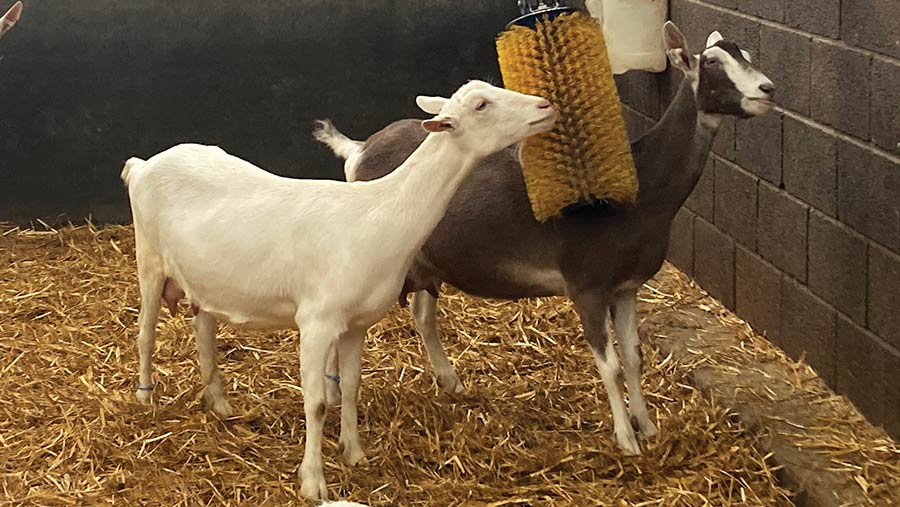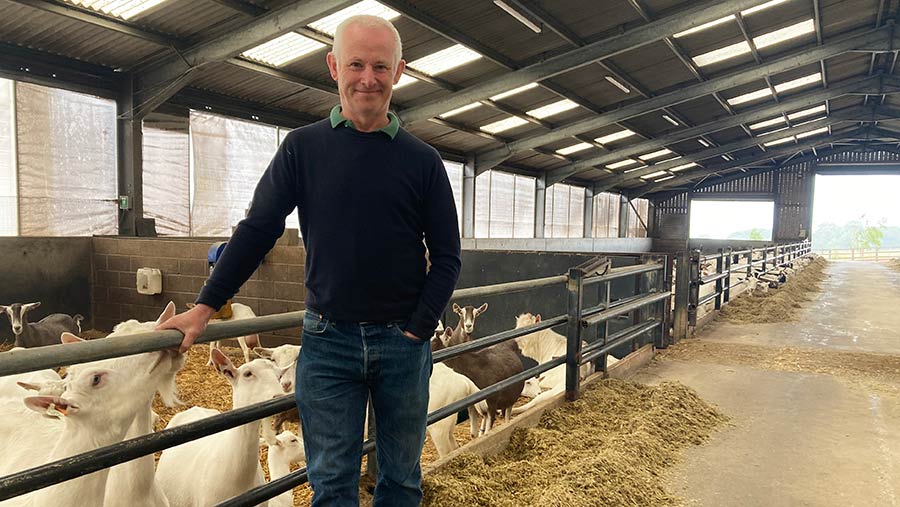How goat herd uses targeted parasite treatments
 © MAG/Michael Priestley
© MAG/Michael Priestley A Gloucestershire goat herd is successfully managing a low parasite risk with a treatment targeted at higher risk animals.
The Whitehouse family’s fully housed and zero-grazed herd of 800 British Saanen and Toggenburg milking goats at Bradley Farm, near Mitcheldean, Gloucestershire, used to be treated with a pour-on twice a year.
Intestinal worm burdens are typically low in housed goat units, so the pour-on was primarily for ectoparasite control and mange, explains Charlie Whitehouse, who started milking goats in 2007.
See also: Can sheep be ‘worm tolerant’ and what are the implications?
Farm facts

Charlie Whitehouse © MAG/Michael Priestley
- 800 British Saanen and Toggenburg milking goats
- Yields 1,200 litres a goat a year
- Sells milk sold as liquid for retail and for cheese processing
- Supplies milk to H Walker and Sons Dairy
- 60 litres a week go into “Oh My Goat” as gelato and direct milk sales
- Farms 810ha (2,000 acres), of which 172ha (425 acres) owned
- 700 Lleyn and Charollais cross ewes
- 650ha (1,606 acres) of combinable crops
- 100 Stabiliser suckler cows
New mindset
The farm started goat milk production with 100-head, and the herd now numbers 800 does.
He believes the days of giving animals medicine “just in case” are over, and there must be an evidence-based approach to using drugs to protect future efficacy.
“For one thing, goat farming is typically very high in veterinary and medicine costs, so targeting products at fewer, higher-risk animals makes sense,” he says.
Old system
Previously, the dual-purpose (internal and external parasites) eprinomectin pour-on was administered to every goat on the farm twice a year.
But the dosage rate risked future parasite resistance issues, explains farm vet Matt Pugh of Belmont Farm and Equine Vets.
“The licence for eprinomectin for goats is at twice the dosage rate of that for cattle,” explains Matt.
“It’s applied at 2ml for every 10kg of bodyweight in goats, as opposed to 1ml per 10kg in cattle.
“However, because the pour-on was only being used to prevent mange, we dosed at a sub-lethal level for internal parasites, so there was a risk the pour-on was inadvertently selecting for parasite resistance.”
Matt adds: “This type of treatment is what the industry wants to get away from, so the farm now has a more targeted plan for internal and external parasites.”
Worm risk
Although the unit has a dedicated team of three full-time and two part-time staff, as well its own telehandler and feeder wagon, the ever-increasing demand placed on time and labour meant pens were not being cleaned out as regularly as they should have been, admits Charlie.
To try to help with staff hours, mucking out the deep straw beds had been extended from every four to six weeks to every eight to 10 weeks – and this may have led to a build-up of worm burden.
Straw is bought from the arable enterprise and topped up every day in the goat shed.
“We extended mucking out periods as a labour efficiency saving,” he says.
“I try and keep hours sensible and ensure people don’t burn out. It seems to work as we have had someone here for 33 years, and the average is about nine years.”
Matt is unsure how the worms are coming into the herd, but says it could be in hay.
“They have more chance of surviving in hay than in a low pH silage,” he suggests.
Worm alert
The increased worm burden was identified and addressed through the following five-step process:
1. Low body condition score (BCS) animal found in routine check
- A lower condition billy with anaemia was found during a pre-breeding soundness examination by Belmont Farm and Equine Vets.
2. Worm sample analysed
- A faecal egg count (FEC) was carried out on a sample of the billy’s droppings. A worm count at the lab found 1,750 eggs per gram (epg) – very high.
- The sample was submitted to the Animal and Plant Health Agency for testing, which concluded the worm burden was trichostrongyle in origin, but there were no haemonchus.
3. FEC rolled out across more animals
- To clarify the extent of the worm burden, 10 early lactation goats (during the peri-parturient rise) and 10 thin goats, at other lactation stages, were individually sampled and egg counts done
- Early lactation goats had egg counts of 50epg (so unlikely to be production limiting), but thin nannies in later lactation averaged 150epg (range 50-850epg), which was deemed to have been a potentially limiting burden.
4. Worm efficacy test conducted on FEC and milk yield
- Owing to historic underdosing of eprinomectin, the vets advised Charlie to do a worm egg reduction test on the three goats with the highest epg and administer a 0.1ml/10kg bodyweight dose of an eprinomectin injectable (Eprecis). Milk yield was recorded at the time.
- Follow-up FECs two weeks later found a 100% kill rate and lifted milk yield in each goat from 1.5 to 2.2 litres, 2.5 to 4 litres and 2 to 3.5 litres respectively.
- A group of 30 mid-lactation goats in good condition and health were treated and no egg count or milk yield response was seen, suggesting the biggest impact was on untreated animals around kidding and early lactation.
5. Action plan drawn up (ongoing)
- The most susceptible goats are treated with Eprecis four to six weeks pre-kidding. This typically might amount to only 100 goats (12% of the herd), and the extended lactations of goats mean most animals are only being treated once every 18-24 months, preserving an “in refugia” population of untreated worms on the farm.
- Last year, only 325 adult goats and 235 new goatlings kidded, with half the herd milking through.
- The only other stock that get treatment are thin goats identified when handled on a quarterly basis for their 12-week clostridial vaccine. Goats that fail to respond to treatment are culled.
- Blanket eprinomectin use has stopped and been replaced with other treatments and methods (see box).
- High-priority (kidding and early lactation) groups are cleaned out every four weeks.
Fly control management
- Two deltamethrin pour-on applications are now used to control ectoparasites
- Automatic climate control in sheds adjusts curtains and fans according to temperature, wind speed, carbon dioxide and ammonia levels
- Fresh, moving air is provided for the milking goats, keeping the insect burden down. Each pen (up to 180 goats) has a 1m fan pulling fresh air from outside the building across the goats
- Parasitic wasp larvae have been experimented with flies
- Two fly zappers are used – one in the milking parlour, one in the kidding unit
